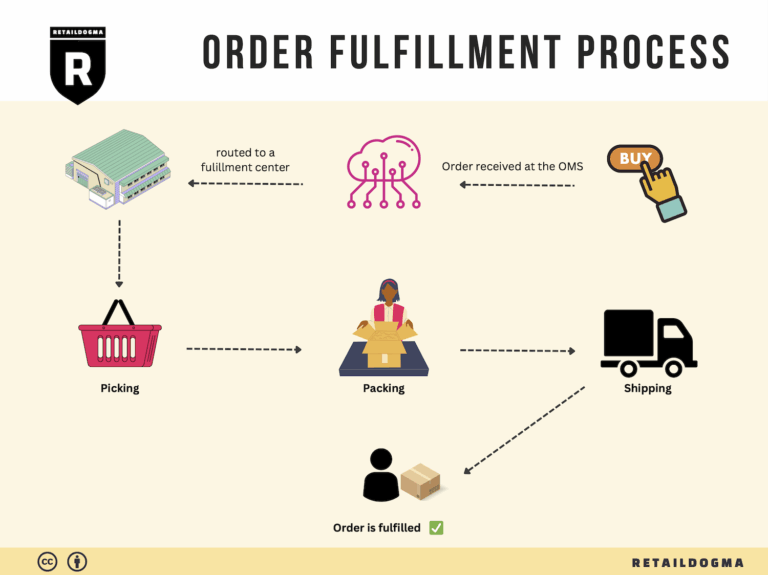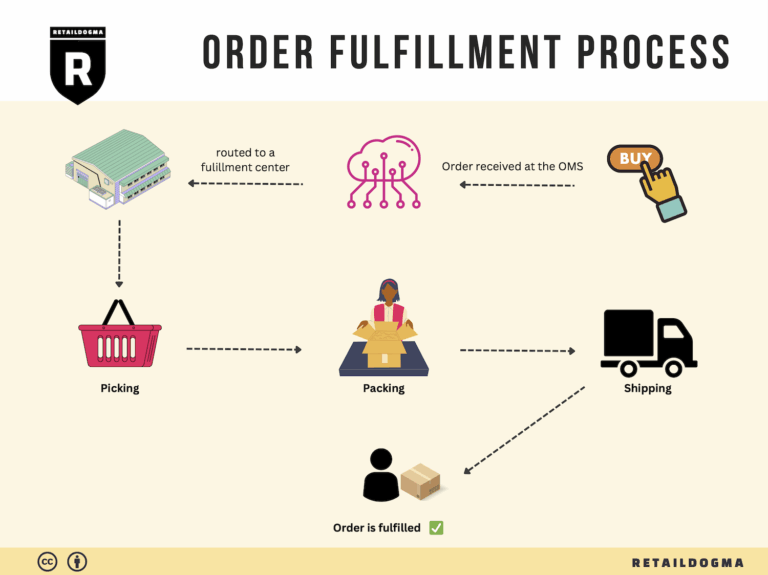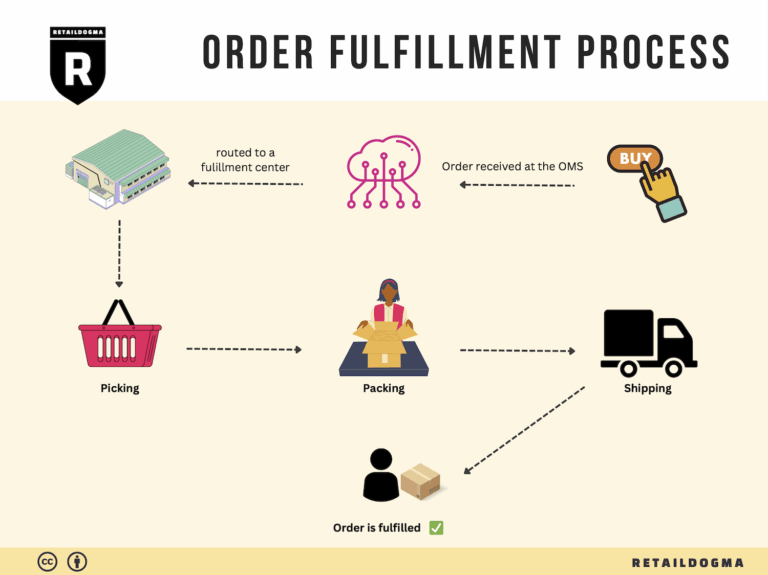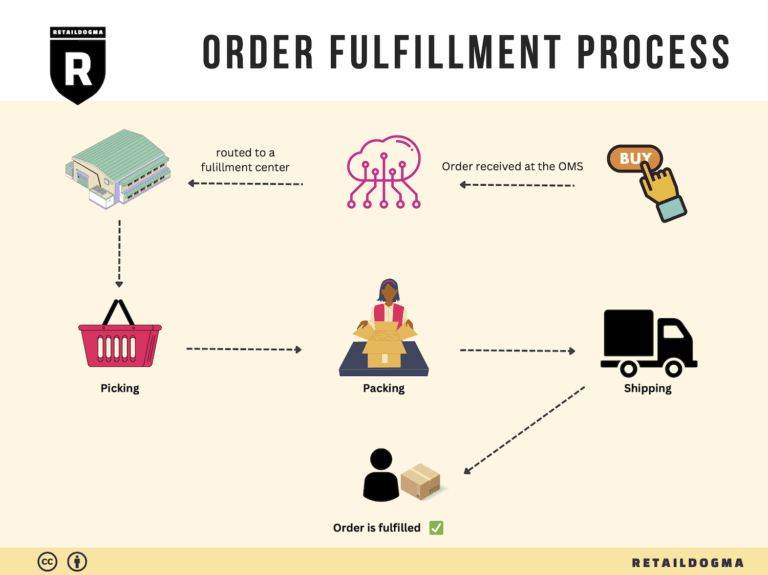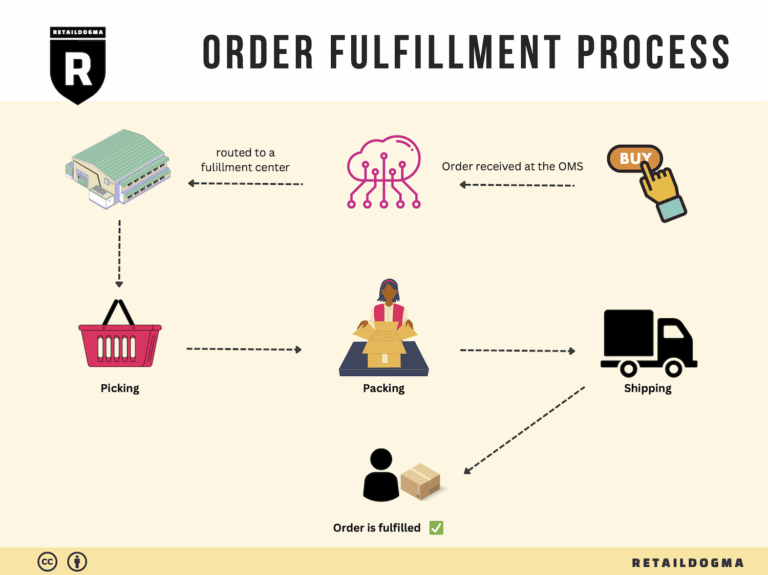What Is A Fulfillment Center? A Complete Guide (2025)
What is E-commerce Fulfillment? An Introduction for Growing Businesses
Understanding E-commerce Fulfillment
As a growing online business owner, you may find yourself grappling with the intricacies of packing and shipping orders. The excitement of making sales can quickly turn into a daunting challenge as you juggle inventory management, order processing, and logistics. This is a common pain point for many entrepreneurs, and it often leads to feelings of being overwhelmed. However, effective e-commerce fulfillment can alleviate these stresses, allowing you to focus on scaling your business instead of getting bogged down in operational details.
At its core, fulfillment is the process of getting a product from your inventory to your customer’s doorstep. It encompasses a variety of tasks, including receiving inventory, storing products, picking and packing orders, and shipping them out. For businesses looking to expand, understanding the different fulfillment models is crucial. Options like Third-Party Logistics (3PL) and Fulfillment by Amazon (FBA) offer unique advantages depending on your business needs.
This guide will delve into these various fulfillment models, providing insights into their core services. You’ll learn about the essential functions of fulfillment centers, such as inventory management, order processing, and shipping. Moreover, we will discuss how to choose the right fulfillment partner. Factors like location, technology capabilities, and customer service will play a vital role in your decision-making process.
Pricing is another critical aspect we will cover. Understanding the cost structures associated with different fulfillment options can help you make informed decisions that align with your budget and growth objectives. From per-order fees to storage costs, having a clear picture of what you will be paying will enable you to better manage your expenses and forecast your profitability.
The ultimate goal of this guide is to empower you with the knowledge necessary to make smart logistics decisions for your e-commerce business. By grasping the fundamentals of fulfillment, you can streamline your operations, enhance customer satisfaction, and ultimately drive growth. As you navigate the complexities of e-commerce fulfillment, remember that the right strategies and partnerships can transform your logistics from a burden into a competitive advantage.
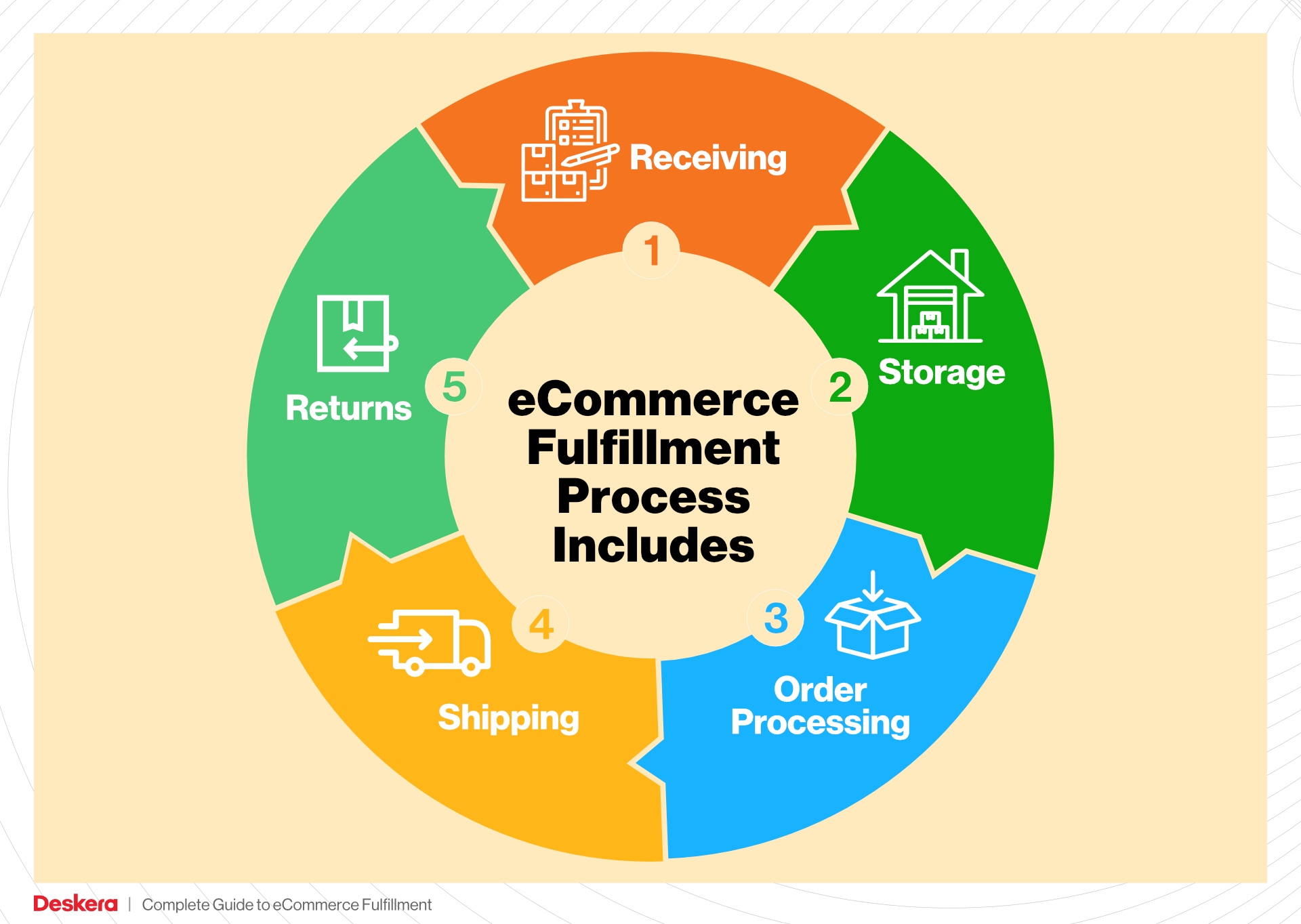
What You’ll Learn In This Guide
- What is E-commerce Fulfillment? An Introduction for Growing Businesses
- The Order Fulfillment Process: From ‘Buy’ Button to Customer’s Door
- Comparing Fulfillment Models: In-House vs. 3PL vs. Dropshipping
- A Deep Dive into Amazon FBA: Pros, Cons, and Who It’s For
- Core Services Offered by Fulfillment Centers
- How to Choose a Fulfillment Partner: A 6-Point Checklist
- Understanding Fulfillment Pricing: A Breakdown of Common Fees
- Frequently Asked Questions (FAQs) about Fulfillment
- Conclusion: Is Outsourcing Fulfillment the Right Move for Your Business?
- Important Disclaimer
The Order Fulfillment Process: From ‘Buy’ Button to Customer’s Door
1. Receiving Inventory
The first step in the order fulfillment process involves receiving inventory at the fulfillment center. This is where products are delivered from suppliers and checked for quality and quantity against purchase orders. This process is critical for maintaining accurate inventory levels and ensuring that products meet quality standards before they are stored.
During receiving, items are typically assigned a Stock Keeping Unit (SKU), which is a unique identifier that helps track inventory. This key term is vital as it allows for efficient management and retrieval of products later in the fulfillment process. Proper receiving procedures not only minimize errors but also enhance the overall efficiency of the supply chain.
2. Warehouse Storage
Once inventory is received, it is sorted and stored in designated areas within the warehouse. Effective warehouse storage strategies are essential for maximizing space and ensuring quick access to products when orders come in. This step often involves categorizing items based on size, type, or sales velocity, and utilizing shelving systems or automated storage solutions.
The importance of organized storage cannot be overstated; it directly impacts the speed and efficiency of order picking later in the process. Utilizing a Warehouse Management System (WMS) can enhance storage operations, allowing businesses to track inventory levels in real-time and manage stock more effectively. A well-planned storage system also reduces the likelihood of stockouts or overstock situations, which can be detrimental to sales and customer satisfaction.
3. Order Picking
Order picking is the process of retrieving items from storage to fulfill customer orders. When an order is placed, a pick list is generated, detailing the SKUs and quantities needed for the order. This step is crucial as it directly affects order accuracy and fulfillment speed.
There are various picking methods, such as single order picking, batch picking, or zone picking, each suitable for different types of operations and order volumes. Efficient order picking ensures that customers receive the correct items quickly, which is essential for maintaining high levels of customer satisfaction and loyalty. Additionally, implementing technology like pick-to-light systems or mobile picking devices can significantly enhance the efficiency and accuracy of this stage.
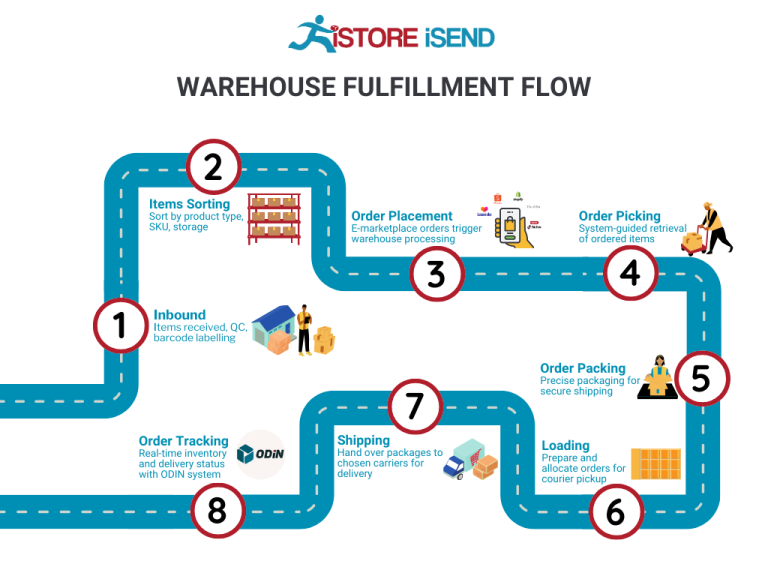
4. Order Packing
After items have been picked, they move to the packing station, where they are prepared for shipment. This step involves checking the picked items against the order details to ensure accuracy, followed by packaging them securely for transit. The choice of packing materials is crucial; it must protect the products while also being cost-effective and environmentally friendly.
Packing is not just about functionality; it also presents an opportunity for branding. Custom packaging can enhance the unboxing experience, leaving a lasting impression on customers. Furthermore, incorporating packing slips and return instructions can improve customer service. The use of packing software can streamline this process, ensuring that the right packaging is used for each order based on size, weight, and destination.
5. Shipping & Delivery
The final step in the order fulfillment process is shipping and delivery. Once packed, orders are labeled and prepared for dispatch. This involves selecting the appropriate shipping carrier based on factors such as cost, delivery speed, and destination. The importance of this stage lies in its direct impact on customer satisfaction; timely and reliable delivery is a key factor in repeat business.
Tracking is a crucial element during shipping, allowing customers to monitor their orders in real-time. Providing tracking information enhances transparency and builds trust with customers. Additionally, businesses must continuously evaluate shipping options to optimize costs and delivery times, including considering partnerships with third-party logistics (3PL) providers for scalability. Efficient shipping processes can lead to reduced shipping costs and improved delivery performance, vital for scaling operations in a competitive e-commerce landscape.
By understanding and optimizing each step of the order fulfillment process, e-commerce businesses can enhance efficiency, reduce costs, and ultimately improve customer satisfaction, setting the foundation for sustainable growth.
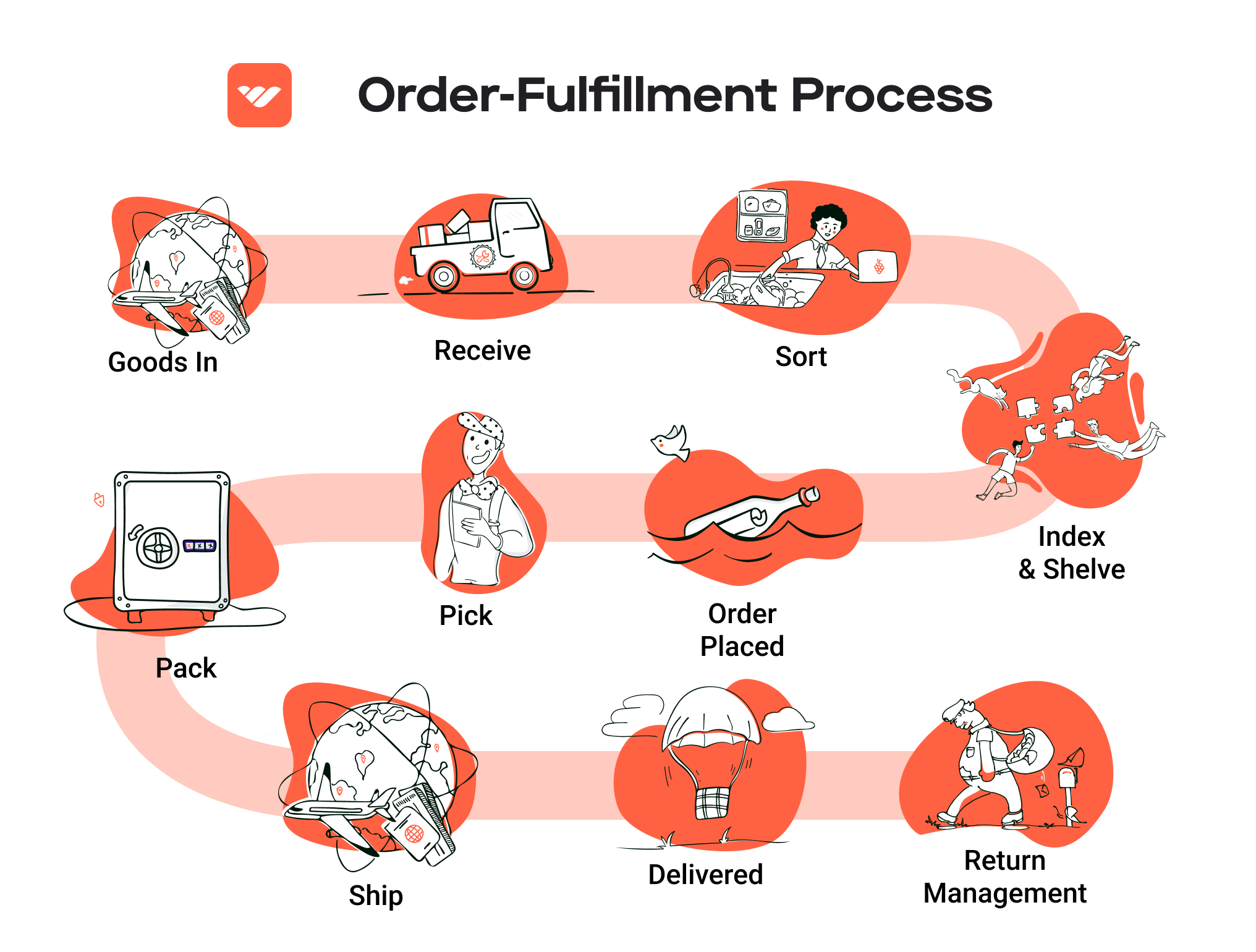
Comparing Fulfillment Models: In-House vs. 3PL vs. Dropshipping
Fulfillment Model Comparison Table
| Model | Who Handles Inventory | Best For (Business Stage) | Key Advantage | Key Disadvantage |
|---|---|---|---|---|
| In-House Fulfillment | Business itself | Established businesses | Full control over inventory and processes | High overhead costs and resource demands |
| Third-Party Logistics (3PL) | Third-party provider | Growing businesses | Scalability and flexibility | Less control over inventory and processes |
| Dropshipping | Supplier | Startups and small businesses | Low upfront investment and risk | Lower profit margins and reliance on suppliers |
In-House Fulfillment
In-house fulfillment involves managing your own inventory, storage, and order processing within your business premises. This model is best suited for established businesses that have the resources and infrastructure to handle their logistics. The key advantage of in-house fulfillment is the level of control it offers. Businesses can directly manage inventory levels, quality control, and order processing speed, which can significantly enhance customer satisfaction. However, this model also comes with significant disadvantages, including high overhead costs related to warehousing, staffing, and technology. Additionally, in-house fulfillment requires a considerable amount of time and effort to maintain operations, which can distract from core business activities, especially as the business scales.
Third-Party Logistics (3PL)
Third-party logistics (3PL) providers take on the responsibility of storing, managing, and shipping inventory on behalf of a business. This model is ideal for growing businesses that are looking to scale without the burden of managing logistics themselves. The key advantage of using a 3PL provider is the scalability and flexibility it offers; businesses can quickly adjust their logistics operations based on demand without making significant investments in infrastructure. Additionally, 3PL providers often come equipped with advanced logistics technology and expertise that can optimize shipping and inventory management. However, the downside is that businesses may have less control over their inventory and fulfillment processes. Quality and service levels can vary significantly between providers, making it crucial to choose a reputable partner that aligns with the company’s operational goals.
Dropshipping
Dropshipping is a fulfillment model where the retailer does not keep goods in stock but instead transfers customer orders directly to a supplier, who then ships the products directly to the customer. This model is particularly appealing for startups and small businesses due to its low upfront investment and minimal risk. The primary advantage of dropshipping is that it eliminates the need for inventory management and warehousing, allowing entrepreneurs to focus on marketing and sales. However, there are notable disadvantages, including lower profit margins since the retailer typically pays wholesale prices, and the reliance on suppliers for product quality and shipping times. Additionally, issues such as stock availability and shipping delays can arise, potentially harming customer satisfaction. Thus, while dropshipping can be a great entry point into e-commerce, it requires careful supplier selection and management to ensure a smooth operation.
By understanding the strengths and weaknesses of each fulfillment model, e-commerce business owners can make informed decisions that align with their operational capabilities and growth objectives.
A Deep Dive into Amazon FBA: Pros, Cons, and Who It’s For
Understanding Fulfillment by Amazon (FBA)
Fulfillment by Amazon (FBA) is a service provided by Amazon that allows sellers to store their products in Amazon’s fulfillment centers. Amazon then takes care of storage, packaging, and shipping, as well as customer service and returns. This service enables sellers to leverage Amazon’s vast logistics network, enhancing their ability to reach customers quickly and efficiently.
How FBA Works
-
Setup: Sellers create an Amazon seller account and enroll in FBA. They list their products on Amazon and prepare them for shipment to an Amazon fulfillment center.
-
Inventory Shipment: Once the products are ready, sellers ship their inventory to Amazon’s designated fulfillment centers. Amazon provides guidelines on how to prepare and package items to ensure they are ready for storage and shipping.
-
Storage: Products are stored in Amazon’s fulfillment centers until a customer orders them. Amazon’s inventory management system keeps track of stock levels.
-
Order Fulfillment: When a customer places an order, Amazon handles the entire fulfillment process. This includes picking the product from storage, packing it securely, and shipping it to the customer.
-
Customer Service: Amazon also manages customer service and returns for FBA orders. This means sellers can focus on growing their business while Amazon handles inquiries and issues.
-
Multi-Channel Fulfillment: Beyond Amazon’s marketplace, sellers can use FBA to fulfill orders from their own websites or other platforms. This allows for a unified inventory management system and shipping process.
Pros of FBA
-
Prime Eligibility: FBA products are eligible for Amazon Prime, which can significantly boost sales. Prime members are more likely to purchase products that offer free and fast shipping.
-
Customer Trust: Utilizing FBA can enhance a seller’s credibility. Customers are more likely to trust products fulfilled by Amazon, knowing they have access to Amazon’s customer service and return policies.
-
Multi-Channel Fulfillment: As mentioned, FBA allows sellers to fulfill orders from other sales channels, not just Amazon. This flexibility can streamline operations and improve customer satisfaction across platforms.
-
Scalability: FBA can help businesses scale quickly without the need for significant investment in warehousing and logistics. Sellers can focus on marketing and product development while Amazon manages fulfillment.
-
Access to Amazon’s Logistics Network: Sellers benefit from Amazon’s extensive distribution network, ensuring faster delivery times and broader reach, which is especially important in today’s fast-paced e-commerce environment.
Cons of FBA
-
High Fees: FBA comes with various fees, including storage fees for inventory and fulfillment fees per unit sold. These costs can add up, particularly for sellers with lower margins or those who sell slow-moving products.
-
Strict Inventory Rules: Amazon has strict guidelines regarding inventory management. Sellers must adhere to these rules to avoid penalties, which can be challenging for those unfamiliar with Amazon’s processes.
-
Commingling Risks: When using FBA, products from multiple sellers may be stored together. This commingling can lead to issues if a seller’s product is returned or damaged, as they may receive a different item back.
-
Limited Control Over Shipping: While Amazon handles logistics, sellers have limited control over how their products are packaged and shipped. This can be a concern for brands that emphasize specific packaging or branding.
-
Potential for Stockouts: If inventory levels are not managed carefully, sellers risk running out of stock, which can result in lost sales and decreased visibility on the Amazon platform.
Who is FBA Best For?
Fulfillment by Amazon is particularly well-suited for:
-
Small to Medium-Sized Businesses: Companies that may lack the resources to manage their own logistics can benefit from FBA’s comprehensive services.
-
E-commerce Entrepreneurs: New sellers looking to enter the market quickly can leverage FBA to simplify their operations and gain access to Amazon’s vast customer base.
-
Brands Seeking Credibility: Businesses that want to build trust with consumers and enhance their brand reputation can benefit from the customer service and reliability associated with FBA.
-
Sellers with High Sales Volume: Businesses with a steady flow of orders can find the fees associated with FBA more manageable, as they can scale operations without significant overhead.
-
Multi-Channel Sellers: Brands selling on multiple platforms can streamline their fulfillment processes through FBA, allowing for a more efficient operation.
In conclusion, Fulfillment by Amazon offers a powerful solution for e-commerce businesses looking to enhance their logistics and customer service capabilities. By understanding both the advantages and challenges of FBA, sellers can make informed decisions about whether this service aligns with their operational goals and business model.
Core Services Offered by Fulfillment Centers
Inventory Management & Warehousing
Effective inventory management and warehousing are the backbone of any successful e-commerce operation. Fulfillment centers, such as those operated by Amazon in Windsor, CT, offer sophisticated systems for tracking and managing inventory levels in real-time. This typically involves the use of advanced software that integrates with e-commerce platforms, allowing businesses to maintain optimal stock levels, reduce carrying costs, and minimize stockouts or overstock situations.
By outsourcing inventory management to a fulfillment center, e-commerce businesses can benefit from:
- Real-Time Tracking: Businesses can monitor inventory levels, sales trends, and reorder points, helping them make informed purchasing decisions.
- Cost Efficiency: With centralized storage, companies can reduce overhead costs associated with maintaining their own warehouses, including rent, utilities, and staffing.
- Scalability: As businesses grow, fulfillment centers can easily adjust to increased inventory needs without the hassle of relocating or expanding physical spaces.
In summary, effective inventory management not only streamlines operations but also enhances customer satisfaction by ensuring that products are readily available when customers want them.
Pick and Pack Services
Pick and pack services are crucial for e-commerce businesses that require efficient order fulfillment. Fulfillment centers employ a systematic approach to picking items from their warehouse and packing them for shipment. This service is designed to optimize speed and accuracy, ensuring that orders are fulfilled correctly and shipped promptly.
The benefits of pick and pack services include:
- Speed: Fulfillment centers often utilize technology, such as barcode scanning and automated picking systems, to accelerate the picking process, reducing the time from order receipt to shipment.
- Accuracy: With dedicated staff and technology in place, the likelihood of errors in order fulfillment decreases significantly, which enhances customer satisfaction and reduces return rates.
- Customization: Many fulfillment centers offer customizable packing options, allowing businesses to add personal touches, promotional materials, or branded packaging that can improve customer experience and loyalty.
Overall, efficient pick and pack services are vital for maintaining a competitive edge in the fast-paced e-commerce landscape, where timely delivery can significantly influence customer decisions.
Kitting and Assembly
Kitting and assembly services allow e-commerce businesses to bundle multiple products into a single package or create new products from various components. This service is particularly beneficial for companies that offer product bundles, subscription boxes, or customized products that require assembly before shipment.
The advantages of utilizing kitting and assembly services include:
- Streamlined Operations: By outsourcing kitting, businesses can focus on core competencies such as marketing and product development while leaving the logistical complexities to the fulfillment center.
- Cost Reduction: Combining products into kits can lead to reduced shipping costs, as multiple items can be shipped together rather than separately, which can also enhance profitability.
- Enhanced Customer Experience: Offering product bundles or custom kits can increase perceived value for customers, leading to higher sales and improved customer satisfaction.
Kitting and assembly services not only improve operational efficiency but also provide an opportunity for businesses to innovate and offer unique product offerings that stand out in the marketplace.
Returns Management (Reverse Logistics)
Returns management, or reverse logistics, is a critical component of e-commerce fulfillment that often gets overlooked. A well-managed returns process can significantly enhance customer satisfaction and loyalty. Fulfillment centers provide streamlined returns management systems that handle the complexities of product returns efficiently.
Key benefits of effective returns management include:
- Customer Retention: A hassle-free return process can improve customer trust and satisfaction, encouraging repeat business and positive reviews.
- Data Insights: Analyzing return data can provide valuable insights into product performance and customer preferences, helping businesses make informed decisions about inventory and product development.
- Cost Efficiency: Fulfillment centers can optimize the returns process, reducing the costs associated with handling returns, restocking, and processing refunds.
In conclusion, a robust returns management system can turn potential losses into opportunities for engagement and improvement, ultimately supporting the long-term success of an e-commerce business.
How to Choose a Fulfillment Partner: A 6-Point Checklist
Location & Warehouse Network
Choosing the right location for your fulfillment partner is crucial for efficient logistics and timely delivery. The proximity of the warehouse to your customer base can significantly affect shipping times and costs.
Why It’s Important
A well-placed fulfillment center can reduce shipping times, lower transportation costs, and improve customer satisfaction. For e-commerce businesses, faster delivery options can be a competitive advantage.
Questions to Ask:
- What is the location of your warehouses, and how many do you operate?
- How do your locations align with our target market?
- What shipping carriers do you partner with, and what are their delivery times?
- Can you provide insights on your average shipping times to major regions?
Technology & Integrations
In today’s digital landscape, a fulfillment partner’s technology stack can be a game-changer. The ability to integrate seamlessly with your e-commerce platform is essential for streamlining operations.
Why It’s Important
Robust technology enables real-time inventory tracking, order management, and reporting. It also minimizes errors and enhances the overall efficiency of the supply chain.
Questions to Ask:
- What warehouse management system (WMS) do you use?
- Can your systems integrate with our current e-commerce platform (e.g., Shopify, WooCommerce)?
- Do you offer API access for custom integrations?
- How do you handle inventory updates, and how frequently is data synced?
Specializations (e.g., Cold Storage, Oversized Items)
Not all fulfillment centers are equipped to handle every type of product. Understanding your specific needs and the partner’s capabilities is essential.
Why It’s Important
If your products require special handling, such as cold storage for perishables or specific accommodations for oversized items, you need a partner that can meet those requirements without compromising quality.
Questions to Ask:
- What types of products are you specialized in handling?
- Do you have the capacity for temperature-controlled storage?
- How do you manage oversized or bulky items?
- What packaging materials do you use to protect products during shipping?
Scalability & Capacity
As your business grows, your fulfillment needs will evolve. It’s important to choose a partner that can grow alongside your business.
Why It’s Important
A scalable fulfillment partner can accommodate seasonal spikes, new product launches, and overall business growth without causing disruptions.
Questions to Ask:
- What is your current storage capacity, and how quickly can you scale if we experience growth?
- How do you manage seasonal fluctuations in order volume?
- Can you provide examples of how you’ve supported other clients during periods of rapid growth?
- What is your process for onboarding new products, and how quickly can you implement changes?
Pricing and Contracts
Understanding the pricing structure and contractual obligations is essential for budgeting and ensuring that there are no hidden fees.
Why It’s Important
Transparent pricing allows you to accurately forecast costs and avoid surprises that can affect your bottom line. A clear contract will outline your obligations and the partner’s responsibilities.
Questions to Ask:
- Can you provide a detailed breakdown of your pricing model?
- What are your fees for storage, fulfillment, and shipping?
- Are there any additional costs we should be aware of (e.g., for returns, special handling)?
- What is the length of your contract, and what are the terms for renewal or termination?
Customer Support & Reviews
The level of customer support you receive can significantly impact your operations. It’s important to partner with a fulfillment center that prioritizes customer service.
Why It’s Important
Effective customer support can resolve issues quickly and minimize disruptions to your business. Additionally, reviews from other clients can provide insights into the partner’s reliability and service quality.
Questions to Ask:
- What customer support channels do you offer (e.g., phone, email, chat)?
- What are your typical response times for support inquiries?
- Can you provide references or case studies from other clients?
- How do you handle customer complaints or issues with order fulfillment?
Conclusion
Selecting the right fulfillment partner is a critical decision that can impact your business’s efficiency, customer satisfaction, and ultimately, your bottom line. By using this checklist to assess potential partners, you can make a more informed decision that aligns with your business goals and customer needs. Be thorough in your evaluation and ensure that the partner you choose is not only capable but also a good fit for your company’s culture and vision.
Understanding Fulfillment Pricing: A Breakdown of Common Fees
Initial Setup Fees
Initial setup fees are typically charged when you first begin using a fulfillment service. These fees can vary widely depending on the provider and the complexity of your operations. They usually cover the costs associated with onboarding your products into the fulfillment center’s system, which includes inventory setup, account creation, and integration with your e-commerce platform.
The setup fee may also include the costs of establishing your storage space within the warehouse and any necessary configuration for your specific products, such as labeling or packaging requirements. It’s essential to clarify with your fulfillment partner what is included in the setup fee and whether it is a one-time charge or if there are recurring costs associated with it.
Receiving Fees
Receiving fees are charged when your inventory arrives at the fulfillment center. These fees cover the labor and resources needed to unload, inspect, and store your goods. The calculation for receiving fees often depends on the volume of items being received and can be structured as a flat rate or based on the number of pallets or boxes.
For example, a fulfillment center might charge a fee per pallet received or a fee per item for smaller shipments. Understanding how these fees are structured is crucial, as they can significantly impact your overall fulfillment costs, especially if you’re frequently restocking inventory.
Storage Fees (per pallet/bin)
Storage fees are incurred for the space your inventory occupies in the fulfillment center. These fees are typically calculated on a per-pallet or per-bin basis, depending on how your products are stored. The fee structure can vary based on the type of products you are storing, their size, and the duration of storage.
For instance, many fulfillment centers offer tiered pricing based on the volume of pallets stored. Larger volumes may qualify for lower per-pallet fees. Additionally, some providers may charge higher rates during peak seasons, such as the holiday shopping period, when storage space is in high demand. To manage storage costs effectively, it’s advisable to keep track of your inventory turnover rates and avoid overstocking.
Pick & Pack Fees (per item/order)
Pick and pack fees are charged for the labor involved in retrieving items from storage and preparing them for shipment. This fee is usually calculated on a per-item basis, meaning the more items you sell, the higher your pick and pack fees will be. Some fulfillment centers also offer a flat fee per order, which can be beneficial for businesses that sell multiple items in a single transaction.
The complexity of the pick and pack process can also affect these fees. For example, if your products require special handling, such as fragile items or customized packaging, you may incur additional charges. Understanding your product mix and how the fulfillment center calculates pick and pack fees can help you estimate costs more accurately.
Shipping Fees
Shipping fees are one of the most variable costs associated with fulfillment and can significantly affect your bottom line. These fees include the costs of transporting your products from the fulfillment center to the customer’s location. Shipping fees can be influenced by several factors, including the shipping method (standard, expedited, etc.), the weight and dimensions of the package, and the destination.
Many fulfillment centers have partnerships with major carriers, allowing them to offer discounted shipping rates. However, it’s essential to understand how these rates are calculated and whether there are additional handling fees. Some providers offer flat-rate shipping options, while others may charge based on actual shipping costs, which can fluctuate based on carrier rates.
Tips for Getting an Accurate Quote
-
Be Transparent: When requesting a quote, provide detailed information about your product dimensions, weights, and expected order volumes. This helps fulfillment centers give you a more accurate estimate.
-
Ask About Hidden Fees: Inquire about any additional fees that may not be included in the initial quote, such as handling fees, seasonal surcharges, or costs associated with returns.
-
Compare Multiple Providers: Don’t settle for the first quote. Compare several fulfillment providers to understand the market rates and what services are included.
-
Consider Long-Term Costs: Look beyond initial setup and shipping costs. Evaluate the overall pricing structure, including storage and pick and pack fees, to ensure you’re making a cost-effective decision for scaling your business.
-
Request Custom Solutions: If your business has unique needs, ask potential partners if they can tailor their services and pricing to better fit your operations.
By understanding the various components of fulfillment pricing and actively engaging with potential partners, you can make informed decisions that support your e-commerce business’s growth and efficiency.
Frequently Asked Questions (FAQs) about Fulfillment
1. What is the Amazon Fulfillment Center in Windsor, CT?
The Amazon Fulfillment Center in Windsor, known as BDL4, is one of the largest fulfillment facilities in Connecticut, measuring approximately 3.5 million square feet. It serves as a hub for receiving, sorting, and shipping millions of consumer goods each week. Opened in 2022, it employs over 3,000 workers and is a critical part of Amazon’s logistics network in the region.
2. How does the fulfillment process work at Amazon?
At Amazon’s fulfillment centers, the process typically includes several key steps:
- Receiving: Products are received from suppliers and stored in the warehouse.
- Storage: Items are stored until they are ordered. Amazon uses a sophisticated inventory system to manage storage efficiently.
- Picking: When an order is placed, items are picked from their storage locations.
- Packing: Picked items are packed into boxes for shipment.
- Shipping: Packages are loaded onto delivery trucks and dispatched to customers.
3. What is the difference between a warehouse and a fulfillment center?
A warehouse primarily focuses on storing products until they are needed, while a fulfillment center is designed for processing customer orders and shipping them directly to consumers. Fulfillment centers typically include advanced technology for inventory management and order processing, whereas warehouses may have a more traditional setup focused on storage.
4. What is a 3PL (Third-Party Logistics)?
A 3PL is a service provider that manages logistics and supply chain functions on behalf of another company. This can include warehousing, transportation, order fulfillment, and distribution. Many e-commerce businesses partner with 3PLs to streamline their operations and reduce costs associated with logistics management.
5. How much do fulfillment services cost?
The cost of fulfillment services can vary widely based on several factors, including the volume of orders, the types of products being stored and shipped, and the specific services required. Typical fees may include storage fees, picking and packing fees, and shipping costs. Businesses should evaluate their needs and compare service providers to find the best pricing structure.
6. What are the benefits of using Amazon Fulfillment Centers?
Utilizing Amazon Fulfillment Centers offers several advantages, including:
- Speed: Amazon’s extensive logistics network allows for rapid order processing and delivery.
- Scalability: Businesses can easily scale operations up or down based on demand.
- Cost Efficiency: Leveraging Amazon’s established infrastructure can reduce overhead costs related to warehousing and shipping.
- Access to Prime: Sellers can offer products with Amazon Prime eligibility, increasing visibility and sales potential.
7. How can I get my products into Amazon’s Windsor Fulfillment Center?
To have your products stored and fulfilled from Amazon’s Windsor center, you need to enroll in the Amazon Seller Central program. Once registered, you can create listings for your products and send inventory to the fulfillment center following Amazon’s guidelines for shipping and packaging.
8. What types of products can be stored at the Amazon Fulfillment Center?
Amazon Fulfillment Centers can store a wide variety of products, including electronics, clothing, household items, and more. However, there are restrictions on certain categories, such as hazardous materials or perishable goods. Sellers should refer to Amazon’s guidelines for a comprehensive list of acceptable products.
9. What should I know about inventory management at Amazon Fulfillment Centers?
Inventory management at Amazon Fulfillment Centers is largely automated, utilizing advanced technology to track stock levels and movement. Sellers must monitor their inventory levels in Seller Central to ensure they have enough stock to meet demand while avoiding excess storage fees. Regularly reviewing sales trends and adjusting shipments accordingly is key to effective inventory management.
10. Are there any challenges to using Amazon Fulfillment Centers?
While there are numerous benefits, challenges include:
- Costs: While leveraging Amazon’s infrastructure can be cost-effective, fees can add up, particularly for storage and fulfillment.
- Control: Sellers may have less control over the fulfillment process and customer service compared to managing their own logistics.
- Competition: With many sellers using the same platform, standing out can be challenging.
By understanding these factors, businesses can make informed decisions about using Amazon Fulfillment Centers in Windsor, CT, to optimize their e-commerce operations.
Conclusion: Is Outsourcing Fulfillment the Right Move for Your Business?
Key Benefits of Outsourcing Fulfillment
Outsourcing fulfillment can be a transformative decision for e-commerce businesses seeking to scale efficiently. The primary advantages include significant time savings, enhanced scalability, and access to specialized expertise. By partnering with a fulfillment service, businesses can offload the complexities of inventory management, order processing, and shipping logistics. This allows owners and managers to focus on core competencies such as product development, marketing, and customer engagement.
Additionally, as your business grows, the ability to scale operations seamlessly becomes crucial. Fulfillment partners like Amazon’s Windsor facility can handle fluctuations in order volume, especially during peak seasons, without the need for businesses to invest heavily in their own infrastructure. This flexibility can lead to improved customer satisfaction, as orders are processed and shipped promptly.
However, the success of outsourcing fulfillment hinges on selecting the right partner. It’s essential to consider factors such as reliability, technology integration, and service quality. A well-chosen fulfillment partner not only meets your current needs but also supports your long-term growth strategy.
Next Steps for Your Business
To determine if outsourcing fulfillment is the right move for your business, conduct a thorough audit of your current shipping and fulfillment processes. Assess your order volume, shipping times, and overall operational efficiency. Are you meeting customer expectations? Are there bottlenecks that could be alleviated through a dedicated fulfillment service?
Taking the time to evaluate these aspects can provide clarity on whether a fulfillment partner could enhance your operational efficiency and support your growth ambitions. As the e-commerce landscape continues to evolve, ensuring that your logistics strategy aligns with your business goals is crucial for sustained success.
Important Disclaimer
⚠️ Important Disclaimer
The information in this guide is for educational purposes. Fulfillment services, pricing, and platform features change frequently. Always conduct your own due diligence and consult with providers directly before making business decisions.

